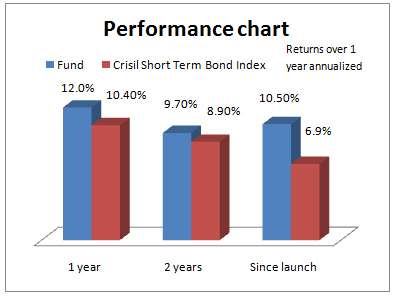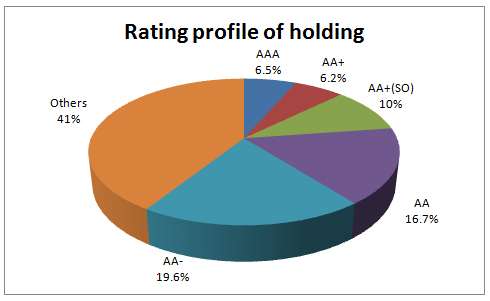The stock market’s phenomenal performance since late 2013 may have shifted all your attention to equity funds. But in the process, you may be missing out on some quiet opportunities that debt funds have been offering. Dozens of schemes, if you take the debt short-term and income fund category, have delivered double-digit returns in the last one year with much of the returns accruing in the past 6 months.
Of course, a majority of these delivered returns by assuming some interest rate risk. But there are a few funds in the income fund category that deliver high returns for taking on a different kind of risk – credit risk – in corporate bonds.
In 2014 thus far, a number of fund houses have started offering what is popularly known as ‘corporate bond’ opportunity funds. One of the earlier schemes to be launched (in 2011) in this space, is Franklin India Corporate Bond Opportunities Fund.
With a return of 12% in the past one year and 10.5% annualised returns since its launch in December 2011, this fund has hogged the limelight in the debt fund category almost since its launch.
Suitability
We do not, in general, choose a fund for the long haul if its record is less than 3 years. Franklin India Corporate Bond Opportunities is 3 months short of this record; yet, we have chosen to recommend this for investors with a reasonable risk appetite, who are willing to hold this fund for 3 years.
Our timing this recommendation now, despite the fund not fulfilling our track record criteria, is to ensure that investors still gain from the narrowing spreads in the corporate bond space. We explain the opportunity in this space in the ensuing section.
This fund is suitable only if you wish to hold it for not less than three years (please note that the fund has a steep exit load for redemptions before this period) and can take some risks. You should also be prepared for short periods of negative returns. The three-year holding period, besides lowering risk, will also ensure you enjoy the capital gain indexation benefit.
Why corporate bond opportunity now
In general, we do not prefer credit risk as an investing idea, especially when the economy is headed downhill. However, with key economic metrics showing signs of revival, and corporate balance sheets slowly deleveraging, the credit risk at this point seems lower than earlier. How do we gauge this?
Less downgrades: One way is to look at corporate credit ratings. The Upgrade to Downgrade Ratio of Crisil for 2013-14 improved to 0.79 times from 0.62 times, suggesting that fewer companies are being downgraded. That means corporate credit risk hasn’t worsened or may have gotten better. Any increase in the number of upgrades would also cause yields to ease, triggering a price rally in bonds.
Default rates: Does the AA-rated category always spell high risk? To understand this, we looked at the default rates of different rated instruments. According to Crisil’s historical data between 1988 to 2013, while AAA-rated instruments had zero default risk, the risk of default for long-term AA-ratings was a mere 0.03% for 1 year and 0.33% for 2 years. That means not even 1 in 100 companies in this rating category defaulted.
With well researched picks in the AA-rated debt category, fund houses can still avoid high credit risk and yet, enjoy higher accruals (interest).
Of course, nil default does not mean no risk. The risk of low liquidity means that a fund can get stuck with an instrument until maturity. This is why a longer tenure is called for in such funds.
Attractive yields: The ‘carry’ or the accruals for a three-year AA+-rated instrument is on an average about 30 basis points higher than their AAA-rated counterparts (which are currently at about 9.5%). For a AA-rated instrument, the similar difference is about 75 basis points over AAA-rated instruments. This spread further increases sharply for instruments with an A rating.
Simply holding these instruments would fetch a high accrual income for the fund. Of course, in the event of economic prospects improving or when rates are cut, the yields will ease leading to capital appreciation. If you believe that the threat of an economic downturn is lower now and that a recovery is in sight, then all of the above factors put together can work in favour of the fund delivering higher returns.
Performance and portfolio

Franklin India Corporate Bond Opportunities has steadily been in the top 10 chart in the income fund category since its launch. Currently, only funds with a good proportion of gilt, or those that take on credit risk, have managed one-year returns closer to this fund.
The fund’s return over the past year, at 12% is 1.5 percentage points higher than its benchmark – Crisil Short-term Bond Index. It is also a good three percentage points above its category average.
Interestingly, two other income funds from the Franklin stable – Franklin India Income Opportunities and Franklin India Income Builder have also done well. However, these funds are different from Corporate Bond Opportunities Fund: the portfolios of the other two funds are not restricted to holding just bonds. They can hold gilts and other short-term instruments. They take on an interest rate risk and assume very limited credit risk.

Franklin India Corporate Bond Opportunities has been consistent in keeping the average maturity of its portfolio at less than 3 years. As of July, its portfolio maturity was 2.7 years and yield to maturity at about 10.7%.
The fund held close to 17% of its assets in AA instruments. This is up from about 7% a year ago. This suggests that the fund is more confident of going for instruments in this space now, perhaps encouraged by improving credit scenario. The fund is managed by Santosh Kamath and Sumit Gupta.
Disclaimer: Returns mentioned are past returns and are not indicative of future performance.
To know how to read our weekly fund reviews, please click here.








Vidya, Can you please throw some light on Gilt funds if it is the good time to buy such funds as we are seeing the rate cuts.
Hello Rachit,
Gilt funds have alredy seen a bit of rally in anticipation of rate cuts. As for rate cuts, I am not sure it is set for the near term. Havign said that, in general we do not recommend pure gilt funds for retail investors as timing is of utmost importance in such funds. Instead, going with an income/dynamic bond fund which has reasonable exposure to g-secs is a less riskier option. thanks, Vidya
As a lay man, i want to ask one thing. You are telling the annual return is 12% and annualized income is 10.5%, these returns we often get from banks when invested as term deposit, then what is the benefits in investing in these funds. please explain in detail.
Hello Rohan, Sorry for the delated response.
Banks currently provide about 9% (avg.) for 3-5 yr deposits. For a person in 30% tax brackets, this translates into 6.3% post tax. Whereas for debt funds as holdings beyond 3 years enjoy capital gains indexation benefit, the post tax benefit is far superior. Pl. take a look at this RBI table to know that it has been very very long since banks gave 10% rate. http://www.rbi.org.in/scripts/PublicationsView.aspx?id=15864
Also those who give so are few and are smaller banks who wish to grow aggressively by collecting deposits. thanks,
As a lay man, i want to ask one thing. You are telling the annual return is 12% and annualized income is 10.5%, these returns we often get from banks when invested as term deposit, then what is the benefits in investing in these funds. please explain in detail.
Hello Rohan, Sorry for the delated response.
Banks currently provide about 9% (avg.) for 3-5 yr deposits. For a person in 30% tax brackets, this translates into 6.3% post tax. Whereas for debt funds as holdings beyond 3 years enjoy capital gains indexation benefit, the post tax benefit is far superior. Pl. take a look at this RBI table to know that it has been very very long since banks gave 10% rate. http://www.rbi.org.in/scripts/PublicationsView.aspx?id=15864
Also those who give so are few and are smaller banks who wish to grow aggressively by collecting deposits. thanks,
Vidya, Can you please throw some light on Gilt funds if it is the good time to buy such funds as we are seeing the rate cuts.
Hello Rachit,
Gilt funds have alredy seen a bit of rally in anticipation of rate cuts. As for rate cuts, I am not sure it is set for the near term. Havign said that, in general we do not recommend pure gilt funds for retail investors as timing is of utmost importance in such funds. Instead, going with an income/dynamic bond fund which has reasonable exposure to g-secs is a less riskier option. thanks, Vidya